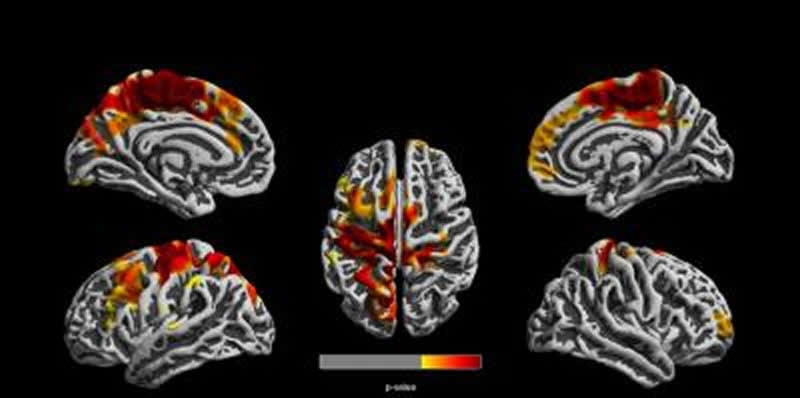Summary: Early-life exposure to high levels of traffic-related air pollution alters the structure of the brain at age 12. Children exposed to air pollution had reduced cortical thickness and gray matter volume compared to children who were not exposed to high levels of pollution.
Source: Cincinnati Children’s Hospital Medical Center
A new study suggests that significant early childhood exposure to traffic-related air pollution (TRAP) is associated with structural changes in the brain at the age of 12.
The Cincinnati Children’s Hospital Medical Center study found that children with higher levels of TRAP exposure at birth had reductions at age 12 in gray matter volume and cortical thickness as compared to children with lower levels of exposure.
“The results of this study, though exploratory, suggest that where you live and the air you breathe can affect how your brain develops, says Travis Beckwith, PhD, a research fellow at Cincinnati Children’s and lead author of the study. “While the percentage of loss is far less than what might be seen in a degenerative disease state, this loss may be enough to influence the development of various physical and mental processes.”

Gray matter includes regions of the brain involved in motor control as well as sensory perception, such as seeing and hearing. Cortical thickness reflects the outer gray matter depth. The study found that specific regions in the frontal and parietal lobes and the cerebellum were affected with decreases on the order of 3 to 4 percent.
“If early life TRAP exposure irreversibly harms brain development, structural consequences could persist regardless of the time point for a subsequent examination,” says Dr. Beckwith.
The researchers on the study, which is published online in PLOS One, used magnetic resonance imaging to obtain anatomical brain images from 147 12 year olds. These children are a subset of the Cincinnati Childhood Allergy and Air Pollution Study (CCAAPS), which recruited volunteers prior to the age of six months to examine early childhood exposure to TRAP and health outcomes.
The volunteers in the CCAAPS had either high or low levels of TRAP exposure during their first year of life. The researchers estimated exposure using an air sampling network of 27 sites in the Cincinnati area, and 24/7 sampling was conducted simultaneously at four or five sites over different seasons. Participating children and their caregivers completed clinic visits at ages 1, 2, 3, 4, 7 and 12.
Previous studies of TRAP suggest that it contributes to neurodegenerative diseases and neurodevelopmental disorders. This work supports that TRAP changes brain structure early in life.
Senior author of the study is Kim Cecil, PhD, a scientist at the Cincinnati Children’s Imaging Research Center.
Source:
Cincinnati Children’s Hospital Medical Center
Media Contacts:
Jim Feuer – Cincinnati Children’s Hospital Medical Center
Image Source:
The image is credited to Cincinnati Children’s Hospital Medical Center.
Original Research: Open access
“Reduced gray matter volume and cortical thickness associated with traffic-related air pollution in a longitudinally studied pediatric cohort”. Travis Beckwith, Kim Cecil, Mekibib Altaye, Rachel Severs, Christopher Wolfe, Zana Percy, Thomas Maloney, Kimberly Yolton, Grace LeMasters, Kelly Brunst, Patrick Ryan.
PLOS ONE doi:10.1371/journal.pone.0228092.
Abstract
Reduced gray matter volume and cortical thickness associated with traffic-related air pollution in a longitudinally studied pediatric cohort
Early life exposure to air pollution poses a significant risk to brain development from direct exposure to toxicants or via indirect mechanisms involving the circulatory, pulmonary or gastrointestinal systems. In children, exposure to traffic related air pollution has been associated with adverse effects on cognitive, behavioral and psychomotor development. We aimed to determine whether childhood exposure to traffic related air pollution is associated with regional differences in brain volume and cortical thickness among children enrolled in a longitudinal cohort study of traffic related air pollution and child health. We used magnetic resonance imaging to obtain anatomical brain images from a nested subset of 12 year old participants characterized with either high or low levels of traffic related air pollution exposure during their first year of life. We employed voxel-based morphometry to examine group differences in regional brain volume, and with separate analyses, changes in cortical thickness. Smaller regional gray matter volumes were determined in the left pre- and post-central gyri, the cerebellum, and inferior parietal lobe of participants in the high traffic related air pollution exposure group relative to participants with low exposure. Reduced cortical thickness was observed in participants with high exposure relative to those with low exposure, primarily in sensorimotor regions of the brain including the pre- and post-central gyri and the paracentral lobule, but also within the frontal and limbic regions. These results suggest that significant childhood exposure to traffic related air pollution is associated with structural alterations in brain.






